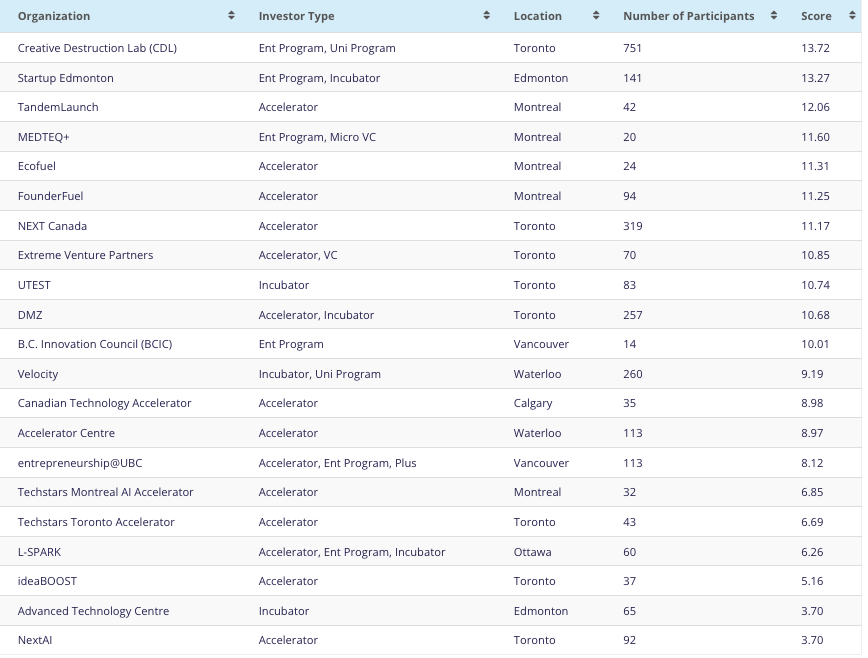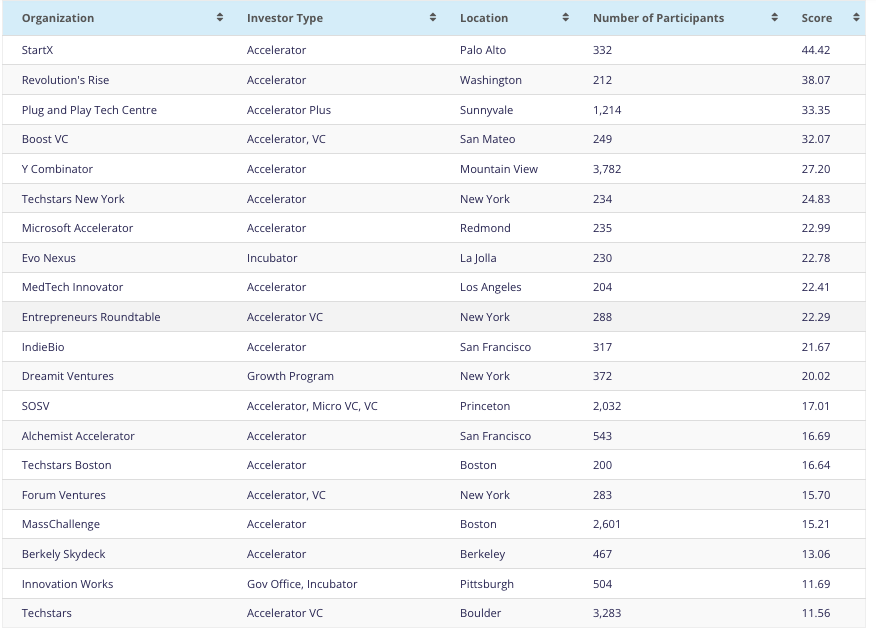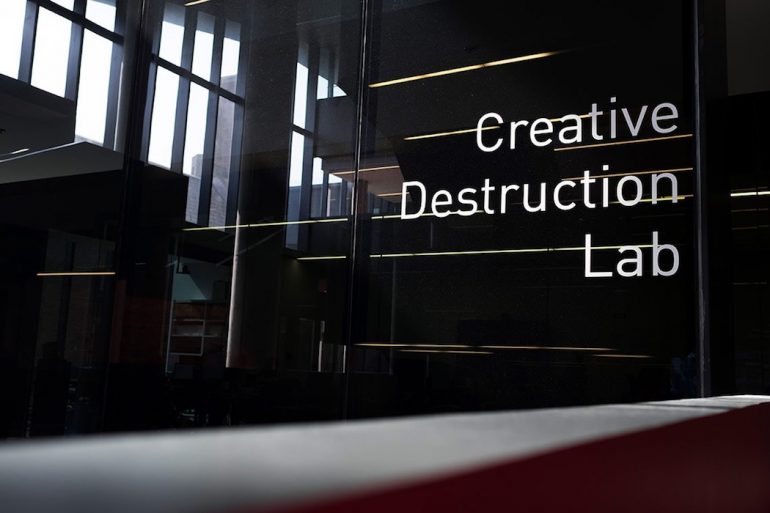Well known for its annual list highlighting Canada’s fastest-growing tech companies, The Narwhal Project has created a new index ranking Canada’s accelerators.
The list includes 21 Canadian accelerators, incubators, and entrepreneurial programs, ranking them based on data collected through Crunchbase in the summer of 2021.
The Narwhal Project creator, Charles Plant, argues the data shows growth in the Canadian tech ecosystem over the past decade, as well as room for improvement, especially when compared to United States counterparts.
“I think it’s important for us to benchmark against the best in the world to see how are we doing.”
Topping the list is Creative Destruction Labs (CDL), featuring the largest number of participants (751), as well as the highest number to have successfully raised capital. Circling out the top five are Startup Edmonton, TandemLaunch, MEDTEQ+, and Ecofuel.
The Narwhal Project’s rankings, while not a complete list of Canadian accelerator-style programs, interestingly show smaller Canadian programs beating out the likes of Next Canada, DMZ, and Techstars Toronto when it comes to portfolio company performance.
Plant also ranked the largest American programs, with results showing Canadian programs still have a ways to go when it comes to reaching the size, scale, and success of their counterparts south of the border.
The Canadian tech landscape is ripe with accelerator, incubator, and entrepreneurial programs looking to support and foster the growing market. But that has not always been the case. According to Plant, 10 years ago hardly any accelerators existed in Canada, but since then, the numbers have burgeoned.
As the country’s tech scene matures, large international accelerators have opened Canadian programs alongside local counterparts. One such example is Techstars Toronto, which was pegged this year by the larger Techstars group to expand its capacity – one of only two cities globally to be chosen due to its strong performance over the last four years.
While there are many programs to choose from, there are also essentially no data-based rankings that show how these programs perform. This data gap is part of what led Plant and the Narwhal Project team to create the rankings.
“It’s a very opaque system,” he told BetaKit. “I think it’s important to be able to judge how companies and institutions in the community are doing. I think it’s important for us to benchmark against the best in the world to see how are we doing against the best, particularly because we can identify practices that will enable us to improve.”
RELATED: Narwhal Project creator looks to apply unicorn research with new accelerator
Another impetus for the research and rankings was Plant’s own work with companies. The Narwhal Project quietly launched its own accelerator this year after Plant was continuously approached by companies who took his workshops on how to become a unicorn company.
The list ranks accelerators according to graduation rate (which Narwhal classifies as companies that raised more than $250,000 in pre-seed or seed funding afterwards); median financial velocity (the speed of raising money); and percentage high velocity (the number of superstars, or companies that have raised more than $10 million a year since inception). To be included in the ranking, an accelerator had to have made 15 or more investments and have 10 or more companies that had received a total investment of greater than $250,000.
The list gives each company a score based on the above criteria. With 10 global locations, CDL is the highest on the list with a score of 13.72. NextAI rounded out the top 21 with a score of 3.70.

Comparatively, StartX tops the American list with a score of 44.42, while Techstars Boulder took the final spot with a score of 11.56.

“The US is graduating companies into a system that immediately applies a lot of capital. In Canada, that application of capital is a bit delayed,” he argued. “As a result, companies don’t grow as fast, don’t get the same results, and that’s why we’re seeing the accelerators showing significantly different levels of results.”
Plant specifically lamented a lack of pre-seed and seed funding in Canada, noting that American accelerators graduate companies into a healthy angel, pre-seed, and seed investment environment. He argued that increasing that and ensuring accelerators connect companies directly with potential investors could improve Canada’s numbers.
While Canada has had a record year so far in venture capital investments, seed investment remains low and is not growing at the same pace as other stages. CVCA data shows that $487 million has been invested year-to-date in 156 seed-stage deals, compared to more than $3.6 billion in 223 early-stage deals.
“The seed stage is crucial to the health of our ecosystem and requires more dollars flowing to it,” CVCA CEO Kim Furlong told BetaKit earlier this year. “We simply need more focus on seed stage.”
Plant called CDL a good example of a Canadian accelerator success story because of the work it does to connect startups with funding opportunities following the program.
RELATED: New accelerator aims to give Black-led startups in the Prairies a kick-start
While The Narwhal Project examined the difference between Canadian and American accelerators, Plant added that, on a numbers basis, it’s an unfair comparison. He believes that, in a few years, as the Canadian accelerators age and move through a cycle of company growth and investment, he’ll be able to compare Canadian and American accelerators more fairly.
“Certainly accelerators like YCombinator are doing extremely well and their numbers are substantially in excess of these numbers [for the Canadian accelerators], but they’re the model for all accelerators; it’s the granddaddy that figured it out early and has had a lot of time to become successful,” Plant said.
Plant sees the rankings as a way for Canadian companies to assess the success of potential accelerator choices, but also hopes to shine light on ways the Canadian tech ecosystem can improve.
He shared optimism that the pre-seed and seed-stage investment landscape is evolving, noting the major exits of startups to the public markets and large funding rounds that have led to a plethora of unicorn companies and, thus, entrepreneurs and angel investors paying-back. He pointed to Backbone Angels as one such example. The 10-person angel group was created by individuals who have helped lead and build Shopify; most recently one of its creators, Arati Sharma, was named Canada’s angel of the year by NACO.
“We’re now creating the wealth in the experienced entrepreneurs that’s going to cycle back in to be available at the pre-seed and angel level for the companies graduating from these accelerators, and that I’m really excited about,” Plant said.


